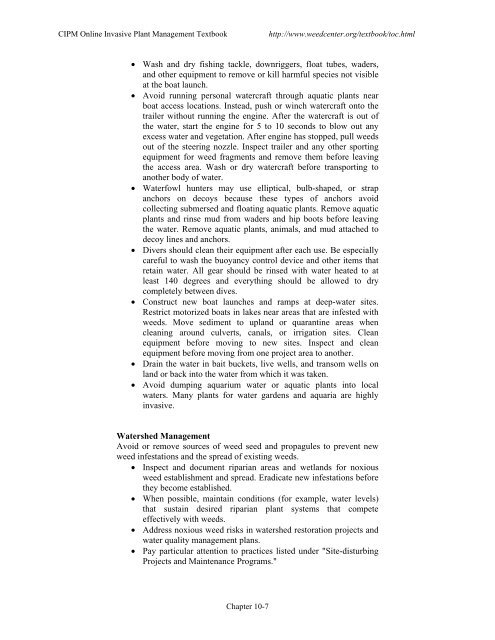Chapter 10 - Center for Invasive Plant Management
Chapter 10 - Center for Invasive Plant Management
Chapter 10 - Center for Invasive Plant Management
Create successful ePaper yourself
Turn your PDF publications into a flip-book with our unique Google optimized e-Paper software.
CIPM Online <strong>Invasive</strong> <strong>Plant</strong> <strong>Management</strong> Textbookhttp://www.weedcenter.org/textbook/toc.html• Wash and dry fishing tackle, downriggers, float tubes, waders,and other equipment to remove or kill harmful species not visibleat the boat launch.• Avoid running personal watercraft through aquatic plants nearboat access locations. Instead, push or winch watercraft onto thetrailer without running the engine. After the watercraft is out ofthe water, start the engine <strong>for</strong> 5 to <strong>10</strong> seconds to blow out anyexcess water and vegetation. After engine has stopped, pull weedsout of the steering nozzle. Inspect trailer and any other sportingequipment <strong>for</strong> weed fragments and remove them be<strong>for</strong>e leavingthe access area. Wash or dry watercraft be<strong>for</strong>e transporting toanother body of water.• Waterfowl hunters may use elliptical, bulb-shaped, or strapanchors on decoys because these types of anchors avoidcollecting submersed and floating aquatic plants. Remove aquaticplants and rinse mud from waders and hip boots be<strong>for</strong>e leavingthe water. Remove aquatic plants, animals, and mud attached todecoy lines and anchors.• Divers should clean their equipment after each use. Be especiallycareful to wash the buoyancy control device and other items thatretain water. All gear should be rinsed with water heated to atleast 140 degrees and everything should be allowed to drycompletely between dives.• Construct new boat launches and ramps at deep-water sites.Restrict motorized boats in lakes near areas that are infested withweeds. Move sediment to upland or quarantine areas whencleaning around culverts, canals, or irrigation sites. Cleanequipment be<strong>for</strong>e moving to new sites. Inspect and cleanequipment be<strong>for</strong>e moving from one project area to another.• Drain the water in bait buckets, live wells, and transom wells onland or back into the water from which it was taken.• Avoid dumping aquarium water or aquatic plants into localwaters. Many plants <strong>for</strong> water gardens and aquaria are highlyinvasive.Watershed <strong>Management</strong>Avoid or remove sources of weed seed and propagules to prevent newweed infestations and the spread of existing weeds.• Inspect and document riparian areas and wetlands <strong>for</strong> noxiousweed establishment and spread. Eradicate new infestations be<strong>for</strong>ethey become established.• When possible, maintain conditions (<strong>for</strong> example, water levels)that sustain desired riparian plant systems that competeeffectively with weeds.• Address noxious weed risks in watershed restoration projects andwater quality management plans.• Pay particular attention to practices listed under "Site-disturbingProjects and Maintenance Programs."<strong>Chapter</strong> <strong>10</strong>-7
















